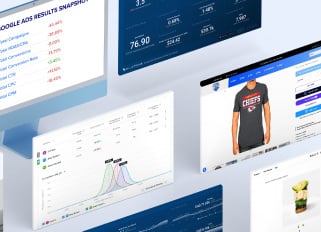
Personalization in E-commerce: How to Use Data to Improve Customer Retention
Customer care is the heart and soul of any business. In spite of great products, approximately 63% of customers will not return (and this number could rise to as high as 80%) if the services provided are poor. And let’s be real… would you go back to a store that doesn’t treat you well?
If you want to retain your customers, you have to show how much they mean to you—even online. As pointed out by tech experts from Cybernews in their recently published article on the best website builders of 2025, e-commerce shops should be easy to navigate, have 24/7 customer support, and be intuitively designed for customer convenience.
To cater to the evolving needs of customers and provide top-notch customer service, it’s best that, as an e-commerce store owner, you stay sensitive and updated to what the customers need.
But where do you start?
That’s where the power of customer data comes in. In this article, we’ll take you through the ins and outs of why customer data empowers personalization in ecommerce.
Keep reading to learn more.

How Personalization in E-commerce Helps Improve Customer Retention
Reaching out to new customers is fun and exciting. But the actual fun—errr, challenging—part of running an online business is making sure that these customers will stay loyal and will keep coming back. That when they need something, the first thing that comes to mind is your e-commerce shop and not your competitors.
Various factors can affect customer retention. Aside from the already mentioned service quality, factors such as product quality, competitive pricing, ease of shopping, loyalty programs, and delivery time can also affect the overall shopping experience.
As a business owner, you can’t keep guessing which of these factors affect customer retention. You have to let the data speak for itself. This saves you time, money, and effort—and most importantly, immediately addresses the concerns raised by customers.
On top of utilizing data to find out the problems encountered by customers, you can also use these pieces of information to enhance and personalize the shopping experience. By looking into your customers' purchase history, online behavior, demographics, payment preferences, location, and social media activities, you can create directed content, motivate repeat purchases, and even encourage loyal customers to refer your e-commerce shop to others.
How Can You Use Data to Improve Customer Retention
When it comes to e-commerce, rather than physical stores, where you get to chat with customers, make personal suggestions, and get straight-up feedback, it works in a totally different way. For one, you can’t be up 24/7 to talk to customers—although you can employ AI and chatbots to do so. However, guess we can agree that despite how sophisticated these tools are, the warmth brought by human interaction remains irreplaceable.
So, how do we make up for the lack of interaction in e-commerce? You turn to data to gauge the kind of experience your customers are having. And to maximize your efforts to retain these customers, you continue to utilize these metrics to identify areas for improvement that may enhance satisfaction and loyalty.
To maximize your retention efforts, these are the following metrics you want to nail down:
1. Customer Retention Rate (CRR)
Yes, you can actually see the percentage of people who stick with your company over a particular period. This metric is often used by subscription and service providers, such as financial institutions, telecom companies, and, of course, retail and e-commerce businesses.
To calculate your customer retention rate, simply choose a timeframe (probably a month or year) and then subtract the number of new customers acquired from the total number of customers at the end of the period.
After which, divide the results by the number of customers at the start and multiply by 100. That’s: CRR = ((End-New)/Start) x 100. For most industries, a good customer retention rate should fall between 70% and 85%.
 2. Repeat Purchase Rate
2. Repeat Purchase Rate
Now, it’s not enough to know how many people made a purchase.. It is also important to know the percentage of those who keep coming back to make another purchase. Again, this is a business you are running—and if you can just get even half your customers to make a second purchase, you’re saving money by not having to market to new leads..
To know the percentage rate, you need two important data points: the number of customers who have purchased more than once in your e-commerce shop and the total number of customers that you have.
By dividing these two, the rate will tell you how your products and services impact your customers. This will also help you forecast the success rate of the products that you will sell in the future, allowing you to strategize more effectively.
3. Average Order Value
Who is your target market? How affordable are your products and services? As a business owner, you have to be mindful of the purchasing power of your customers.
In other words, you need to know how much they can feasibly spend in a transaction. After figuring this out, you can implement strategies to meet the financial capabilities of your customers and keep them loyal to your business.
While the numbers may not exactly reflect the margin that you are generating per order, the figures can provide valuable insights on how you can further improve customer retention. To do this, you just have to divide the total number of revenues by the total number of orders within a certain period.
How to Implement Personalized Strategies in E-commerce to Improve Customer Retention
Obviously, it’s not enough to have the data and know how to calculate it. You have to capitalize on it, too.
If you use this information to personalize the customer experience in your e-commerce store, chances are you'll increase conversion rates. This can be done by:
- Personalizing product recommendations based on interest, product searches, and purchase history
- Creating personalized emails, newsletters, and chats using customer data to make communication more engaging
- Implementing special incentives and programs based on customers' purchasing habits to encourage repeat purchases
- Making the platform user-friendly and intuitive by allowing customers to save products or create wish lists, with notifications sent when items are back in stock
- Posting personalized content on social media and ads that are inspirational, eventful, and culturally relevant to your audience, such as holidays, festivities, and the like
- Staying updated on the latest trends and assessing how responsive your customers are to these trends, as well as how quickly they engage with them
Conclusion
It should now be clearer that running an e-commerce shop involves more than just selling products and reaching out to customers. You have to stay creative to keep them. And one way to do that is by using data to improve customer retention.
With a more personalized platform and way of communicating with customers based on their preferences and behavior, you can create a shopping experience that extends beyond screens. One that can make people feel seen, valued, and understood. That makes them feel nurtured. That is worth returning to.
Is your e-commerce shop giving your customers this kind of experience? To help you with your customer retention strategies, allow us at Bluetuskr to be your marketing partner!
Connect With Us
Recent Post

.png)





Tell us what you think!